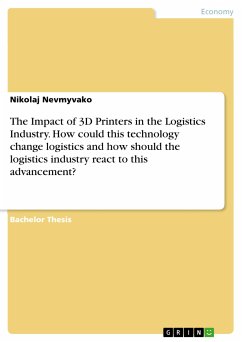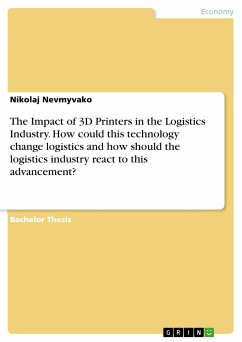Bachelor Thesis from the year 2014 in the subject Business economics - Supply, Production, Logistics, grade: 2,0, Hochschule Ostwestfalen-Lippe - University of Applied Sciences (University of Applied Sciences), course: logistics systems design and optimization, language: English, abstract: The market situation tends to move towards shorter development times and, at the same time, increased product complexity and the demand for individual products. Against this backdrop, 'additive manufacturing processes' have proven to be effective tools. They allow a fast process in product manufacturing. In recent years, these methods have been further developed, especially the 3D printing process has experienced significant improvements in quality, precision and material range. The main advantage of said method is that it can be produced directly from CAD data to the computer via the 3D printer. In addition, virtually any desired geometries can be produced. Thus, one can create, for example, nested cavities that, with classical injection molding, would only be possible with increased effort or even not at all. Today, not only plastics can be printed into physical objects, but also raw materials ranging from concrete to paper and metal. Bioengineers can, under laboratory conditions, print human tissue structures of living cells with their medical printers. The manufacturing industry has already taken advantage of this technology and uses it to produce prototypes, small series parts and tools. Alongside the illustrated technological development, the production and innovation activities have been increasingly focused more towards customers. For this type of process design, the customer is integrated into a section of the value chain of the company and undertakes activities that previously were performed by the company. Currently, many 3D printing events are taking place. Intensive debates are being held about an upcoming industrial revolution. This is characterized by a complete shift in production and innovation activities to the customer and is referred to in practice as "democratization of production". Accordingly, the customer is not only able to devise, but also to independently produce. This is possible because of the 3D printer. Against this backdrop, the global management consultancy McKinsey & Company referred to the 3D printer as a disruptive technology. Accordingly, this technology is capable of fundamentally changing entire markets and value chains. If this is the case, the development will also influence the logistics industry. How could this technology change logistics, and how should the logistics industry react to this advancement? "Let's wait and see" would probably be the worst strategic position in today's dynamic environment.
Bitte wählen Sie Ihr Anliegen aus.
Rechnungen
Retourenschein anfordern
Bestellstatus
Storno









